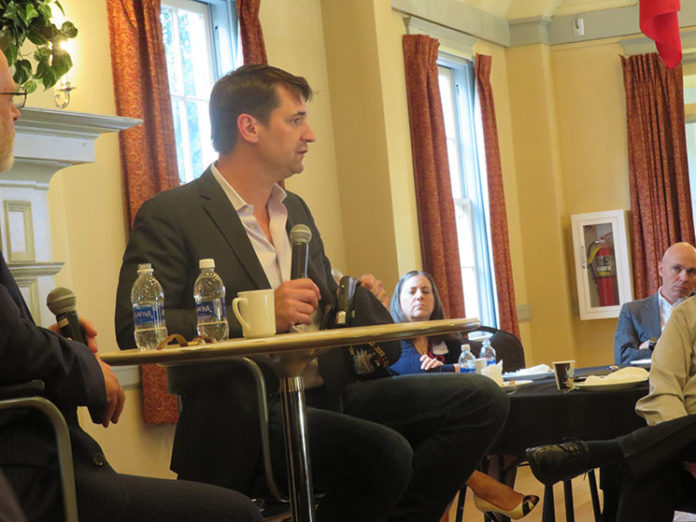
Those who attended this morning’s Boardroom Breakfast event, held in the Red Cross Building at the Fort Vancouver National Historic Site, were able to hear from Andy Lowery, CEO of RealWear, Inc. RealWear is a global leader in augmented reality (AR) hardware technology for industry, originally kicking off with their HMT–1 product. This product is a voice-driven, hands-free, head-mounted tablet that is designed for skilled technicians and engineers in field service, equipment inspection, maintenance and complex manufacturing assembly.
John McDonagh, co-publisher of the Vancouver Business Journal and president of the Greater Vancouver Chamber of Commerce, spoke with Lowery in front of an audience of community members and business leaders about his lengthy career with the U.S. Navy as a nuclear surface warfare officer, how the RealWear, Inc. company came to be and the future of the AR technology that RealWear markets.
Here are 10 things those who attended the breakfast learned about Lowery and RealWear:
1. Lowery’s first job was as a paperboy when he was in the fourth/fifth grade. He woke up before school around 4 or 5 in the morning, got the papers ready and delivered them around his apartment complex. Lowery said he saved up all the money he made to buy his first computer and his first computer game, a game called Dungeons of Daggorath.
“At a very early age I was already getting up at 5 a.m. just to get my hands on a computer,” Lowery said.
2. Prior to getting into his work with technology, Lowery worked in the construction industry for a very brief time, and also worked as a cook at a TGI Fridays restaurant.
3. When Lowery first decided to join a branch of the U.S. Armed Forces, he wanted to join the Marines. The day he went to the Marine Corps recruiter’s office, the door was closed and a sign was displayed that said, “Out today, back tomorrow.” As Lowery was leaving, he walked past an open door and a man called out to him saying, “Sir!, do you know who those Marines work for? They work for the Navy.” Hours later, Lowery had joined the U.S. Navy.
4. When the RealWear company first moved into its headquarters in the Artillery Barracks building on the Fort Vancouver National Historic Site one year ago, there were eight people working for the company. Today, one year later, there are 40. Lowery said they project they will have well over 100 employees by the end of 2019.
5. RealWear sells the HMT–1 product for $2,000 for a single unit.
6. Lowery described RealWear as a “knowledge transfer platform.”
7. RealWear first got its start out of a little company called Kopin. Dr. Chris Parkinson, co-founder and CFO of Kopin, is the main inventor of the HMT–1 system and shortly after Lowery met with Parkinson, RealWear was born. Parkinson asked Lowery to step in as CEO of RealWear in 2016.
8. Although RealWear originated out of the Silicon Valley area, Lowery quickly decided he needed a different location for the company’s headquarters and conducted a trade study, looking at locations like Seattle and Portland. He eventually settled on Vancouver after Parkinson’s wife, who is from the Portland/Vancouver Metro area, told Lowery about the Fort Vancouver Site and the Artillery Barracks building.
9. Of locating the RealWear headquarters to Vancouver, Lowery has said that the company has absolutely found its home and the right culture here in Vancouver.
10. Although the wearable HMT–1 tablet was designed for those working in field service, industry and manufacturing, other industries have been quickly showing interest in the product, including the medical industry, automotive industry and even professional athletes.



